

Online public access catalog. An online public access catalog (often abbreviated as OPAC or simply library catalog) is an online database of materials held by a library or group of libraries.
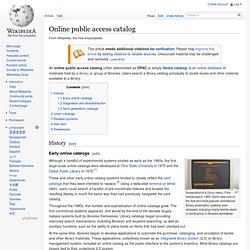
Users search a library catalog principally to locate books and other material available at a library. History[edit] Early online catalogs[edit] Although a handful of experimental systems existed as early as the 1960s, the first large-scale online catalogs were developed at Ohio State University in 1975 and the Dallas Public Library in 1978.[1] These and other early online catalog systems tended to closely reflect the card catalogs that they were intended to replace.[2] Using a dedicated terminal or telnet client, users could search a handful of pre-coordinate indexes and browse the resulting display in much the same way they had previously navigated the card catalog.
Throughout the 1980s, the number and sophistication of online catalogs grew. Stagnation and dissatisfaction[edit] Next-generation catalogs[edit] What is Online Public Access Catalog (OPAC) OCLC. See Wikipedia:OCLC for its use in Wikipedia.
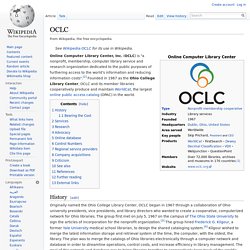
Online Computer Library Center, Inc. (OCLC) is "a nonprofit, membership, computer library service and research organization dedicated to the public purposes of furthering access to the world’s information and reducing information costs".[2] Founded in 1967 as the Ohio College Library Center, OCLC and its member libraries cooperatively produce and maintain WorldCat, the largest online public access catalog (OPAC) in the world. History[edit] Originally named the Ohio College Library Center, OCLC began in 1967 through a collaboration of Ohio university presidents, vice presidents, and library directors who wanted to create a cooperative, computerized network for Ohio libraries.
The group first met on July 5, 1967 on the campus of The Ohio State University to sign the articles of incorporation for the nonprofit organization.[3] The group hired Frederick G. Online Public Access Catalog. Understanding MARC Bibliographic: Machine-Readable Cataloging. Understanding MARC Bibliographic: Machine-Readable Cataloging Written by Betty Furrie in conjunction with the Data Base Development Department of The Follett Software Company Eighth edition reviewed and edited by the Network Development and MARC Standards Office, Library of Congress Published by the Network Development and MARC Standards Office, Library of Congress Available from: Copyright ©2009 The Library of Congress, except within the U.S.A.
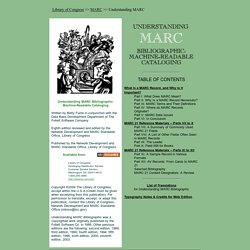
Understanding MARC Bibliographic was a copyrighted work originally published by the Follett Software Co. in 1988. Cataloging. Cataloging (or cataloguing) is the process of listing something for inclusion in a catalog.
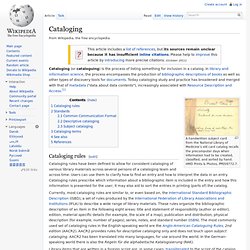
In library and information science, the process encompasses the production of bibliographic descriptions of books as well as other types of discovery tools for documents. Today cataloging study and practice has broadened and merged with that of metadata ("data about data contents"), increasingly associated with Resource Description and Access.[1] A handwritten subject card from the National Library of Medicine’s old card catalog recalls the precomputer days when information had to be created, classified, and sorted by hand. HMD Prints & Photos, PP059772.7. Cataloging rules[edit] Cataloging rules have been defined to allow for consistent cataloging of various library materials across several persons of a cataloging team and across time.
Library items that are written in a foreign script are, in some cases, transliterated to the script of the catalog. MARC standards. MARC (MAchine-Readable Cataloging) standards are a set of digital formats for the description of items catalogued by libraries, such as books.
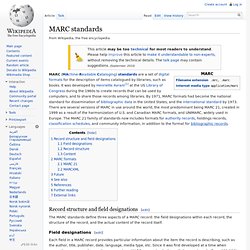
It was developed by Henriette Avram[1] at the US Library of Congress during the 1960s to create records that can be used by computers, and to share those records among libraries. By 1971, MARC formats had become the national standard for dissemination of bibliographic data in the United States, and the international standard by 1973. There are several versions of MARC in use around the world, the most predominant being MARC 21, created in 1999 as a result of the harmonization of U.S. and Canadian MARC formats, and UNIMARC, widely used in Europe.
The MARC 21 family of standards now includes formats for authority records, holdings records, classification schedules, and community information, in addition to the format for bibliographic records. Record structure and field designations[edit] Field designations[edit] Record structure[edit]